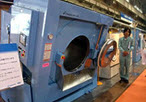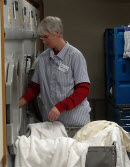Laundry Risk Factors and Best Practices -Part II
Responsibilities of commercial laundry staff can include washing, drying, steaming, ironing, and chemically treating fabrics for use in hospitals, hotels, and other settings. Laundry can be heavy, treated with chemicals, and the work environment can be hot and humid. Work area set up, proper tools, staff training, machine maintenance, and good body mechanics are essential for laundry staff safety.
This 3 part blog summarizes the general hazards and controls for three major activities or tools in commercial laundry operations.
- Part I: Bins, Bags and Carts
- Part II: Washing and Drying
- Part III: Sorting and Folding
If you are looking for more detail on industrial laundry safety, check MEMIC’s live Hotel Safety Webinar on May 8 at 10am EST. Click here for more details.
Activity or Tool: Washing and Drying
Washing and drying laundry can be especially challenging for laundry staff. Commercial washers and dryers found in most hospitality settings vary in size, but generally take loads of about 75 lbs. Loading and unloading these machines can be physically demanding due to the volume and weight of the material and the configuration of the machine. Fully loaded washers and dryers can require significant force to unload when linens have become tangled up in the cycle. Add to that a long reach into a machine over a cart and we have a recipe for an injury.
1) Risk Factors:
a) Awkward postures
i) Shoulder, trunk, upper body, wrist and elbow postures when reaching into and pulling laundry out of the machines
b) Repetitive motions
i) Grasping, lifting, reaching, bending
c) Excessive force exerted when pulling laundry out of the machine.
d) Chemical and bloodborne pathogen exposure
2) Controls:
a) Engineer the Space (if possible)
i) Raise the machines off the floor making loading and unloading easier
ii) Install tilting machines
iii) Ensure machines are no deeper than 25-30 inches for small laundry operations
b) Administrative Controls

i) Bin Placement
(1) Use a bin that is at or lower than the level of the opening of the machine
(2) Place the bin to the side of the machine
(a) This will ensure room enough to stand directly in front of the machine, limiting reaching and twisting over laundry bins.
ii) Use specialized tools
(1) Tools such as laundry hooks and rakes can help prevent reaching into or awkward bending to reach laundry at the back of the machines
iii) Limit load sizes when possible
(1) Overloading washers and dryers can increase the work necessary to untangle and pull out each item.
iv) Use the correct size bin
(1) Purchase and label bins, that are the same load size as the washer, to prevent overloading
v) Proper body mechanics
(1) Train workers in proper bending and lifting techniques
(a) Support upper body with opposite hand when reaching into a machine or over a cart or table
c) Chemical and Pathogen Safety
i) Use of latex or nitrile gloves, aprons, and safety glasses can help prevent contact with harsh chemicals and bloodborne pathogens
ii) Read and understand the Safety Data Sheets (SDS - formerly MSDS) for the chemicals you will be working with and around
iii) Ensure proper ventilation in the laundry space 
(1) Use room ventilation where present
(2) Open doors and windows

